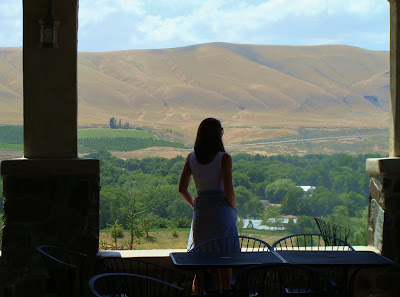The other side of the world
Nothing lends itself to artful depictions more than a vineyard. Rolling hills, gentle green canopies, plump grapes – magnificent. I love pictures of vineyards and their surrounding environments. In Eastern Washington, we live in the midst of some breathtaking vistas.
But getting out of your comfort zone every once in awhile can lead to whole new outlooks. So I went to Africa. My husband, his brother and our sister-in-law just finished an up-and-down, all-around trip to South Africa and Mozambique. We were visiting a few of our kids – my daughter and nephew – who are adventurous souls, devoting a good chunk of their youth to working with other cultures in a far corner of the world. The Peace Corps brought them both to Africa. Cathy lives in a Zulu village, working with the women and youth there.
Marty is in Mozambique, leading a massive effort to replant Mount Gorongosa, a wildy rich and diverse ecosystem that has been stripped by poachers and loggers. They have big jobs with huge challenges, and enough optimism and energy to accomplish great things.
This is one gorgeous piece of the world.
With some gorgeous vineyards
And some gorgeous wines. Here’s the thing about touring a new wine region – I never feel as if I found the best of the best. We had only one day in the Stellenbosch and Paarl regions, and we stopped at only four or five wineries. We had some great wines, some so-so bottles, and at least one that was downright bad.
But we tasted enough intriguing wines in the midst of some of the world’s most beautiful vineyards to make it a memorable day. Our tour included the largest corporate-style wine cooperative in the country,
along with several privately owned, albeit commercially oriented, wineries.
What we missed were the small producers, the hands-on artisan winemakers, the likes of which make up the vast majority of Washington’s 700-plus wineries. South Africa’s industry is centuries older than the New World’s, so the mom-n-pop wineries aren’t so prevalent, but there are certain truths that persist no matter where you make your wine. Number one – you need a great product. And Number two, a marketing twist doesn’t hurt.
Take Fairview. This farm, in the Paarl region, has a long and colorful history dating to the late 17th century. The first wines were made on the farm in 1699. Today, it produces a full menu of varieties including Sauvignon Blanc, Chenin Blanc, Riesling and Viognier, along with big reds like Mourvedre, Pinotage, Cabernet Sauvignon, Merlot and their signature Shiraz. The farm is also one of South Africa’s largest producers of artisanal goat cheeses, all produced from Fairview’s herd of Saanen dairy goats. The tasting fee allows you to taste six different wines, pairing them with a wide array of cheeses. (Notable – White Rock with Apricots, a white-veined blue cheese infused with the sweet fruit. Delicious.)
But the best way to sell wine, to my mind, is to let your customers get a little dirty. We signed on for Waterford Estate’s wine safari, beginning with a tour of the winemaking facility and barrel room, and a taste of the estate’s sparkling wine.
Then we jumped into a Land Rover for a spin through rocky, arid vineyards surrounded by olive trees and craggy sandstone cliffs. Waterford is located in the Blau Klippen Valley. The name means blue stones, and the vineyard’s red clay is speckled with namesake pebbles.
We stopped near a pond at the base of the Olives Vineyard to kick around the rocks while tasting a delicious Blanc de Noir, blended from Sangiovese, Mourvedre, Grenache and Barbera. Next up was a 2009 Sauvignon Blanc, followed by a toasty, cinnamony Chardonnay that had been aged six months in French oak.
Back in the Land Rover, we moved across the farm to a higher elevation planted to red varieties. Kevin Arnold, Waterford’s winemaker and part owner, crafts smoothly nuanced, velvety reds, big with flavors of spice and plum (2008 Kevin Arnold Shiraz), vanilla-tinged red fruits (2008 Cabernet Sauvignon), and rich tobacco (2007 The Jem, Waterford’s signature blend of 60% Cabernet Sauvignon, 15% Shiraz, 5% Mourvedre, 7.5% Malbec and Cabernet Franc, and 2.5% Barbera and Sangiovese).
This was our last stop of the day, and by this time we’d not only pushed our driver deep into overtime, but had begun to focus more on conversation with our wine guides, and the stunning scenery, than on the wines themselves. That’s ok. I’m not a wine critic, just a happy traveler enjoying new views, and I believe that your first spin through a new wine territory should encompass all it has to offer – scenery, people, foods, as well as the wines. I have no way of knowing if the wines we tasted represent the best of Stellenbosch and Paarl, but I'm pretty sure they don't. I do know that we enjoyed them. South African wines are worth exploring again. I’ll be looking for them here at home, where I can consider them in a neutral setting. But I’ll be picturing their point of origin at the Cape of Good Hope.




































